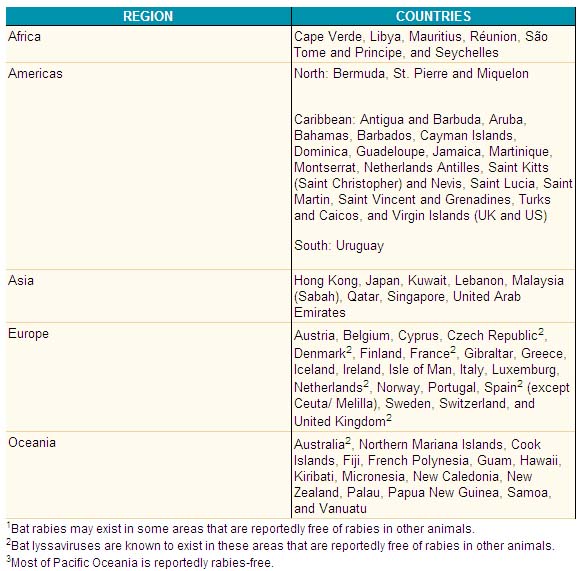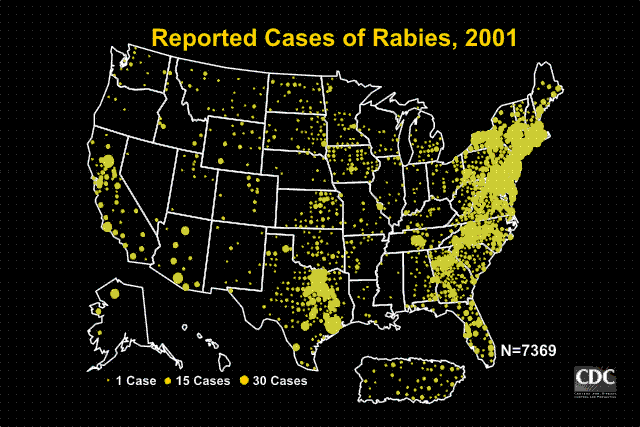Rabies epidemiology and demographics: Difference between revisions
No edit summary |
No edit summary |
||
| Line 4: | Line 4: | ||
==Overview== | ==Overview== | ||
==Epidemiology and Demographics== | ==Epidemiology and Demographics== | ||
===Prevalence=== | ===Prevalence=== | ||
'''Worldwide''' | '''Worldwide''' | ||
* Canine rabies is known to be endemic in parts of Africa, Asia, and Central and South America | * Canine rabies is known to be endemic in parts of Africa, Asia, and Central and South America. Dogs account for over 99 % of all rabies transmission to humans | ||
'''United States''' | '''United States''' | ||
* Human rabies cases in the United States are rare, with only 1 to 3 cases reported annually | * Human rabies cases in the United States are rare, with only 1 to 3 cases reported annually | ||
| Line 219: | Line 218: | ||
[[Image:Table rabies.jpg|left|frame|Countries and political units reporting no indigenous cases of rabies during 2005]] | [[Image:Table rabies.jpg|left|frame|Countries and political units reporting no indigenous cases of rabies during 2005]] | ||
<br clear="left" /> | <br clear="left" /> | ||
=== Age === | |||
* Worldwide, children under 15 years of age have a higher rabies exposure risk, and most exposures are from dog bites<ref name="urlWHO | Rabies2">{{cite web |url=http://www.who.int/mediacentre/factsheets/fs099/en/ |title=WHO | Rabies |format= |work= |accessdate=}}</ref> | |||
=== Case-mortality rate === | === Case-mortality rate === | ||
Revision as of 20:39, 27 September 2017
|
Rabies Microchapters |
|
Diagnosis |
|---|
|
Treatment |
|
Case Studies |
|
Rabies epidemiology and demographics On the Web |
|
American Roentgen Ray Society Images of Rabies epidemiology and demographics |
|
Risk calculators and risk factors for Rabies epidemiology and demographics |
Editor-In-Chief: C. Michael Gibson, M.S., M.D. [1]
Overview
Epidemiology and Demographics
Prevalence
Worldwide
- Canine rabies is known to be endemic in parts of Africa, Asia, and Central and South America. Dogs account for over 99 % of all rabies transmission to humans
United States
- Human rabies cases in the United States are rare, with only 1 to 3 cases reported annually
- Twenty-three cases of human rabies have been reported in the United States in the past decade (2008-2017). Eight of these were contracted outside of the U.S. and its territories
- In 2001, 49 states, the District of Columbia, and Puerto Rico reported 7,437 cases of rabies in animals and no cases in humans, according to CDC (Hawaii is the only state that has never reported an indigenously acquired rabies case in humans or animals). The total number of reported cases increased by 0.92% from those reported in 2000 (7,369 cases).
Incidence
Worldwide
United States
| 5-May-17 | 21-May-17 | VA | 65 | F | Bite | Dog, India |
| 25-Nov-15 | 1-Dec-15 | PR | 54 | M | Bite | Dog-mongoose, Caribbean |
| 17-Sep-15 | 3-Oct-15 | WY | 77 | F | Contact | Bat, Ln |
| 30-Jul-15 | 24-Aug-15 | MA | 65 | M | Bite, Philippines | Dog, Philippines |
| 12-Sep-14 | 26-Sep-14 | MO | 52 | M | Unknown | Bat, Ps |
| 16-May-13 | 11-Jun-13 | TX | 28 | M | Unknown, Guatemala | Dog, Guatemala |
| 31-Jan-13 | 27-Feb-13 | MD | 49 | M | Kidney transplant | Raccoon, eastern United States |
| 6-Jul-12 | 31-Jul-12 | CA | 34 | M | Bite | Bat,Tb |
| 22-Dec-11 | 23-Jan-12 | MA | 63 | M | Contact | Bat, My sp |
| 3-Dec-11 | 19-Dec-11 | SC | 46 | F | Unknown | Bat,Tb |
| 1-Sep-11 | 14-Oct-11 | MA | 40 | M | Contact, Brazil | Dog, Brazil |
| 21-Aug-11 | 1-Sep-11 | NC | 20 | M | Unknown (organ donor)§ | Raccoon, eastern United States |
| 14-Aug-11 | 31-Aug-11 | NY | 25 | M | Contact, Afghanistan | Dog, Afghanistan |
| 30-Jun-11 | 20-Jul-11 | NJ | 73 | F | Bite, Haiti | Dog, Haiti |
| 30-Apr-11 | Survived | CA | 8 | F | Unknown | Unknown |
| 24-Dec-10 | 10-Jan-11 | WI | 70 | M | Unknown | Bat, Ps |
| 2-Aug-10 | 21-Aug-10 | LA | 19 | M | Bite, Mexico | Bat, Dr |
| 23-Oct-09 | 20-Nov-09 | VA | 42 | M | Contact, India | Dog, India |
| 20-Oct-09 | 11-Nov-09 | MI | 55 | M | Contact | Bat, Ln |
| 5-Oct-09 | 20-Oct-09 | IN | 43 | M | Unknown | Bat, Ps |
| 25-Feb-09 | Survived | TX | 17 | F | Contact | Bat, unknown |
| 19-Nov-08 | 30-Nov-08 | MO | 55 | M | Bite | Bat, Ln |
| 16-Mar-08 | 18-Mar-08 | CA | 16 | M | Bite, Mexico | Fox,Tb related |
The English Channel, dog licensing, killing of stray dogs, muzzling and other measures contributed to the eradication of rabies from the United Kingdom in the early 20th century. More recently, large-scale vaccination of cats, dogs and ferrets has been successful in combatting rabies in some developed countries.
The rabies virus survives in wide-spread, varied, rural fauna reservoirs. However, in Asia, parts of Latin America and large parts of Africa, dogs remain the principal host. Mandatory vaccination of animals is less effective in rural areas. Especially in developing countries, pets may not be privately kept and their destruction may be unacceptable. Oral vaccines can be safely distributed in baits, and this has successfully reduced rabies in rural areas of France, Ontario, Texas, Florida and elsewhere. Vaccination campaigns may be expensive, and a cost-benefit analysis can lead those responsible to opt for policies of containment rather than elimination of the disease.
Many territories, such as the United Kingdom, Ireland, Taiwan, Japan, Hawaii, Mauritius, Barbados and Guam, are free of rabies, although there may be a very low prevalence of rabies among bats in the UK; see below.
New Zealand and Australia have never had rabies.[2] However, in Australia, the Australian Bat Lyssavirus occurs normally in both insectivorous and fruit eating bats (flying foxes) from most mainland states. Scientists believe it is present in bat populations throughout the range of flying foxes in Australia.
Additional information can be obtained from the World Health Organization (http://www.who.int/rabies/rabnet/en/), the Pan American Health Organization (http://www.paho.org/english/ad/dpc/vp/rabia.htm), the Rabies Bulletin-Europe (http://www.rbe.fli.bund.de), the World Organization for Animal Health (http://www.oie.int/eng/en_index.htm), local health authorities of the country, the embassy, or the local consulate’s office in the United States. Lists are provided only as a guide, because up to date information may not be available, surveillance standards vary, and reporting status can change suddenly as a result of disease re-introduction or emergence.
Countries and political units reporting no indigenous cases of rabies during 2005:

Age
- Worldwide, children under 15 years of age have a higher rabies exposure risk, and most exposures are from dog bites[1]
Case-mortality rate
- Worldwide, 55,000 human deaths occur annually from rabies[2]
- More than 99% of all human deaths from rabies occur in Africa, Asia, South America and India which report thirty thousand deaths annually.[3] One of the sources of recent flourishing of rabies in the East Asia is the pet boom. China introduced the "One-dog policy" in November 2006 to control the problem.[4]
- The number of human rabies deaths in the United States attributed to rabies has been steadily declining since the 1970’s thanks to animal control and vaccination programs, successful outreach programs, and the availability of modern rabies biologics
Non-human rabies

Wild Animals
Wild animals accounted for 93% of reported cases of rabies in 2001. Raccoons continued to be the most frequently reported rabid wildlife species (37.2% of all animal cases during 2001), followed by skunks (30.7%), bats (17.2%), foxes (5.9%), and other wild animals, including rodents and lagomorphs (0.7%). Reported cases in raccoons and foxes decreased 0.4% and 3.5% respectively from the totals reported in 2000. Reported cases in skunks, and bats increased 2.6%, and 3.3% respectively from the totals reported in 2000.
Outbreaks of rabies infections in terrestrial mammals like raccoons, skunks, foxes, and coyotes are found in broad geographic regions across the United States. Geographic boundaries of currently recognized reservoirs for rabies in terrestrial mammals are shown on the map below.
Domestic Animals
Domestic species accounted for 6.8% of all rabid animals reported in the United States in 2001. The number of reported rabid domestic animals decreased 2.4% from the 509 cases reported in 2000 to 497 in 2001.
In 2001, cases of rabies in cats increased 8.4%, whereas those in dogs, cattle, horses, sheep and goats, and swine decreased 21.9%, 1.2%, 1.9% and 70.0% respectively compared with those reported in 2000. Rabies cases in cats continue to be more than twice as numerous as those in dogs or cattle. Pennsylvania reported the largest number of rabid domestic animals (46) for any state, followed by New York (43).
Successful vaccination programs that began in the 1940s caused a decline in dog rabies in this country. But, as the number of cases of rabies in dogs decreased, rabies in wild animals increased, as shown in the graph below.
References
- ↑ "WHO | Rabies".
- ↑ "WHO | Rabies".
- ↑ "Rabies vaccine". WHO - Immunization, Vaccines and Biologicals. Retrieved 2006-04-20.
- ↑ The Toronto Star "China cracks down on rabid dog menace"